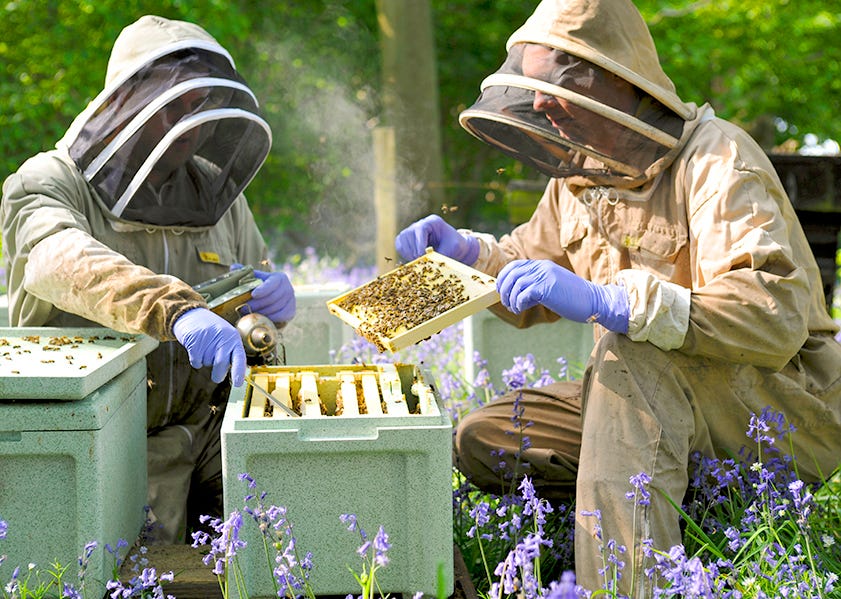When The Bee Stings - What I Learned Going Viral (Again)
Lighting matches in the social media fireworks factory. It's all fun and games until you’re trending in a way that ruins your Google results for a decade.
I am a 32nd degree Scottish Rite Freemason. I’ve always appreciated the symbols we carry—not because they’re cryptic or mysterious, but because they contain plain, old truths dressed in poetic clothes. One of my favorites is the beehive. You’ll often find it tucked quietly into Masonic art and literature, sometimes overlooked, but always meaningful.
The beehive represents industry, cooperation, and the dignity of honest labor. In Freemasonry, it's not just a symbol of being busy—it’s a symbol of being usefully busy, of contributing to something larger than yourself, of understanding that no one builds the temple alone. Every bee has a role, and every role has worth.
It also reminds us that even the smallest creature, acting in harmony with others, can create something lasting and sweet. The hive doesn’t thrive on chaos or ambition—it thrives on order, discipline, and mutual care. For Freemasons, it’s a quiet exhortation to keep at your work, keep your tools sharp, and keep in mind the needs of the whole.
That’s why I named this project THE BEE. Because writing, like building, is work. Because good stories, like good lodges, require effort and harmony. And because in a world full of noise, the steady hum of the hive is still one of the most hopeful sounds I know.
But things don’t always go smoothly and bees can get into some trouble sometimes.
The contemplation of the Bee Hive seems particularly relevant these days.
In The Lost Symbols of Freemasonry, Dr. David Harrison reports that a beehive was discovered at Rosslyn Chapel during the recent renovations. It was inside a rooftop pinnacle that had been hollowed-out by the masons for this purpose. The bees entered through a hole in a decorative flower on the pinnacle. It is interesting in that its construction did not allow for the extraction of honey. The sole purpose appears to have been to protect the bees from the bad weather of the region.
According to the American Preston-Webb Ritual it is explained as a symbol of industry and co-operation, and as cautioning against intellectual laziness, warning that “he that will so demean himself as not to be endeavoring to add to the common stock of knowledge and understanding, may be deemed a drone in the hive of nature, a useless member of society, and unworthy of our protection as Masons.”
The earliest known Masonic reference to the beehive is found in an MS entitled A Letter from the Grand Mistress of the Female Free-Masons to Mr Harding the Printer, found in the Halliday Collection, Royal Irish Academy, Dublin. This document is believed to have been created between 1727 and 1730, and while originally attributed to Jonathan Swift, the true author remains unknown.
“A bee has in all Ages and Nations been the Grand Hierogliphick of Masonry, because it excells all other living Creatures in the Contrivance and Commodiousness of its Habitation or combe; … nay Masonry or Building seems to be of the very Essence or Nature of the Bee, for her Building not the ordinary Way of all other living Creatures, is the Generative Cause which produces the Young ones….”
“For this Reason the Kings of France both Pagans and Christians, always Eminent Free-Masons, carried three Bees for their Arms…”
“What Modern Masons call a Lodge was for the above Reasons by Antiquity call’d a HIVE of Free-Masons, and for the same Reasons when a Dissention happens in a Lodge the going off and forming another Lodge is to this Day call’d SWARMING.”
The hive was really buzzing this week on social media.
I love social media. But in fairness, I’m not a normal user. Like in many aspects of my life, on social media I’m all sending and no receiving. So I don’t read or get my information or news from social. And I don’t think I’ve ever read or posted on anyone else’s personal page on any of the platforms.
But I do like seeing people’s pictures and keeping up with their goings and doings. You can keep up with a thousand interesting people and places in the time it would take to write out a single postcard.
These days I still like to post pictures on Facebook, and otherwise I use it as a kind of billboard for what I’m doing in music, on TV, or in writing, which I’ve now consolidated mostly here in THE BEE.
But this week wasn’t typical.
Two of the THE BEE essays from this week — the ones discussing the memes and framing used online by his critics to define Mark Carney ahead of the upcoming federal election turned out to be of great interest on social media.
This has happened to me a couple times before on Facebook, and it makes for a busy week. It is for sure a double-edged sword. It’s fun when something you write is of wide interest. When you write or produce independently that means you hear directly from the viewers - no broadcaster or publisher to intermediate. Since most of my work is both impenetrably long and of limited interest, it doesn't happen often that I feel like I’ve really connected with the outside world. It’s fair. Only so many people are interested in 7,500 words on the revised history of the Progressive Conservative movement in Nova Scotia or whatever.
The first time it happened, over ten years ago, was an essay I wrote about what I perceived as unchecked and imbalanced power of “bouncers” in the bar scene in downtown Halifax, and their unhealthy relationship with the police who worked downtown. That caused me a lot of trouble, which lingers even now and still dominates Google if you search my name. It was both an obvious and easily observable truth that was well known by many — and an unspeakable betrayal from the perspective of bar staff, the police, and a certain constituency of folks who find comfort and meaning in that kind of power.
I learned a few lessons from the experience. But, unfortunately for my family, maybe, I didn’t learn to shut up. What I have learned is that speaking out is the surest way to have critics.
I’ve noticed—and maybe you have too—that when someone speaks out, especially about politics or power, the response is rarely neutral. You’ll get praise, you’ll get pushback, and sometimes you’ll get a kind of reaction that feels less like disagreement and more like a punishment for thinking out loud. Soren Kierkegaard once said, “People demand freedom of speech as a compensation for the freedom of thought which they seldom use.” It’s a sharp line, but it rings true—because when someone does use both, they often find themselves a little bit out on a limb. Not because they’re trying to be provocative, but simply because they’re not repeating the script. It’s something I think about often when writing THE BEE, and something I’ll keep wrestling with in the essays to come. I’m looking for lines of talk and ways of thinking about the issues of the day that don’t just repeat what I’ve heard along the way. It’s harder than you would think.
A dozen years later since the bouncer incident: untold injury, misery, and humiliation suffered by would-be downtown revelers, many serious injuries, at least one death, and recently, one long-time popular night club closed; it doesn’t seem like much has changed, and nothing has been solved. Except that folks are drinking and going to bars less. And I’m still glad I spoke out.
Anyway, this week was similar. Carney supporters said there has never been a better post, and Poilievre supporters said there has been such a bad one. And I got to talk to a lot of people and hear a lot of points of view that I would not otherwise. Most supportive — I think we’re going to see a landslide Liberal majority victory — and some folks truly cross with me.
Friday, I was invited to Sheldon MacLeod’s new radio show to discuss all this dicey business of talking publicly about politics without losing your mind or your friends.
You might be interested. But given that you are reading this, it’s almost certain you already know more about this than I do.
Thank you for reading
It’s a strange thing, this little digital town square we’ve built on social media—a place where postcards turn into manifestos, where jokes can be evidence, and where an essay you wrote at the kitchen table after midnight can kick off a weeklong political bar brawl. But I wouldn’t trade it. These moments, messy and maddening as they are, remind me that people are paying attention—that I’m part of something larger—and that somewhere in all the shouting, we’re still trying to understand one another and the true complexity in which we live.
So thank you for reading, reacting, and sometimes (a few of you) even ranting. There’s more to come here on THE BEE—more essays, more questions, more stories that might rattle the hive a little. Stay tuned.
Finally, I wanted to share a nice update. I started THE BEE almost a year ago because I wanted to write long-form about different ways of looking at the issues of that day. For whatever reason, my conscience will not release me from this stuff, and it’s either share it or bust. It’s a quirk. It’s been going on noticeably since before I started to school. These days on THE BEE I’m getting about 27,000 reader views a month and noticeably growing, and it’s making enough money to - kind a sort a - justify the late night writing efforts and week end mornings… at least until the weather gets nicer.










I and the other brother bees celebrate your work! But, do beeware of the hornets' nests!